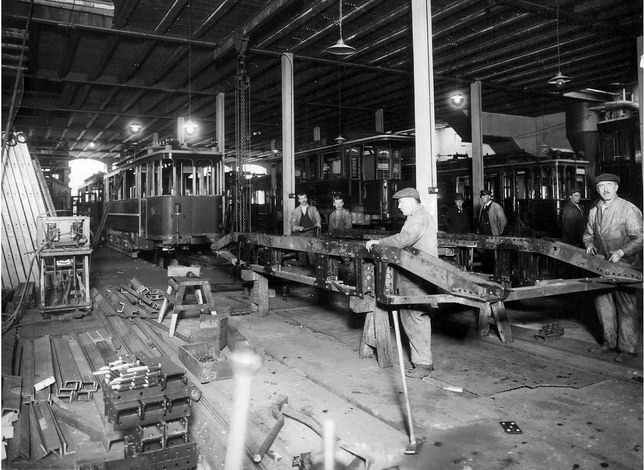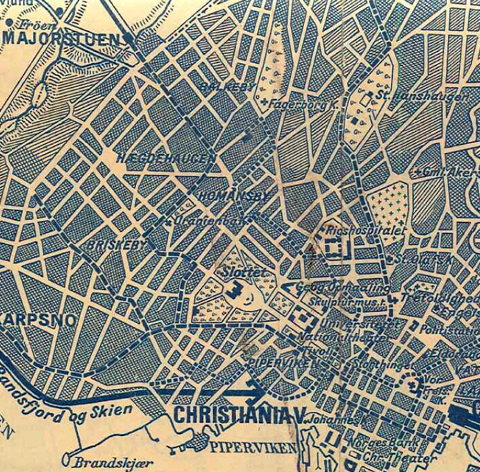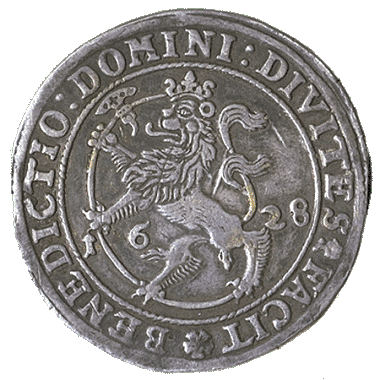|
Homansbyen Depot
Homansbyen Depot ( no, Homansbyen vognhall), officially Kristiania Sporveisanlæg ("Kristiania Tramway Installation") was an Oslo Tramway depot located at Sporveisgata 8 near Bislett in Oslo, Norway. It was constructed for Kristiania Sporveisselskab in 1874 and was the first tramway depot in the country. The facilities were designed by Henrik Thrap-Meyer and featured an administrative office, a horse stable, a forge, a workshop, a weighing shed, and a wagon depot. It had space for 28 horse wagons, 16 sleds, and 116 horses. The administrative office was built in brick and housed apartments, offices, and a laboratory for the veterinarian. The depot was reconstructed several times, and taken out of use in 1966. It was demolished three years later, and replaced with residential apartment blocks. History The tramway operating company Kristiania Sporveisselskab was established on October 2, 1874, and started scheduled horse tram services on October 6, 1875. The network comprised a li ... [...More Info...] [...Related Items...] OR: [Wikipedia] [Google] [Baidu] |
Homansbyen Vognhall 1922
Homansbyen is a neighborhood in Frogner borough in Oslo, Norway. The area is named for the lawyer brothers Jacob (1816-1868) and Henrik Homan (1824-1900). Area The area is located between the streets of Pilestredet in the east, and Uranienborgveien in the west. It consists of Josefines street or Underhaugsveien in the north, Oscars street in the middle, and Grønnegata to the south. The boundaries are thus to Bislett in the east, Hegdehaugen in the north, Uranienborg in the west and southwest, behind the Royal Palace in the south. Hegdehaugsveien goes through the district (north-south), and here is a tram stop which is called Homansbyen. History Along with Jacob Homan, Johan Collett bought the land property Frihedssæde in 1853 with the purpose of dividing up and selling as housing lots. A year later Homan and Lars Rasch bought the property Frydendal. At the time the properties were located outside the urban area of Oslo. Few buyer were interested, and in 1857 Collett sold hi ... [...More Info...] [...Related Items...] OR: [Wikipedia] [Google] [Baidu] |
Milorg
Milorg (abbreviation of militær organisasjon – military organization) was the main Norwegian resistance movement during World War II. Resistance work included intelligence gathering, sabotage, supply-missions, raids, espionage, transport of goods imported to the country, release of Norwegian prisoners and escort for citizens fleeing the border to neutral Sweden. History Following the German occupation of Norway in April 1940, Milorg was formed in May 1941 as a way of organizing the various groups that wanted to participate in an internal military resistance. At first, Milorg was not well coordinated with the Special Operations Executive (SOE), the British organization to plan and lead resistance in occupied countries. In November 1941 the Milorg became integrated with the High Command of the Norwegian government in exile in London, answering to the British Army's Department British Field Office IV, which dealt with sabotage operations, but Milorg's British counterpart, SOE ... [...More Info...] [...Related Items...] OR: [Wikipedia] [Google] [Baidu] |
Briskeby Line
The Briskeby Line ( no, Briskebylinjen) is a line of the Oslo Tramway in Norway. It runs westwards from Jernbanetorget in the city center, passing through the neighborhoods of Briskeby and Uranienborg before reaching its terminus at Majorstuen. The section from Jernbanetorget to Inkognitogata is shared with the Skøyen Line; on this section it connects with the important transport hub Nationatheatret. This part is variously served by route 11, 12 and 13. From the Inkognitogata stop, the line moves through the residential areas around the Royal Palace, in the streets named Riddervolds gate, Briskebyveien, Holtegata and Bogstadveien. The part of the line in Bogstadveien from Majorstuen to Rosenborg is also served by route 19, which operates the Homansbyen Line. When Kristiania Elektriske Sporvei opened the line on 3 March 1894, it was the first electric tramway in Scandinavia. Originally the line ran through Parkveien instead of Inkognitogata and was mostly single track. The trac ... [...More Info...] [...Related Items...] OR: [Wikipedia] [Google] [Baidu] |
Rosenborg Tram Stop
Rosenborg, formerly Uranienborgveien is at tram stop on the Briskeby Line of the Oslo Tramway. It is located in Josefines gate, close to its street junction with Bogstadveien. It serves the neighborhoods , Hegdehaugen and Uranienborg in the West End of Oslo. The station is preceded and succeeded by Bogstadveien and Briskeby, respectively. The station used to be near the junction of Holtegata and Uranienborgveien streets, but it was moved towards Hegdehaugen and Rosenborg in 2009, after the line had been upgraded and reconstructed. In 2014, it was moved even further towards Rosenborg, and consequently renamed. In the same move, the former Rosenborg stop was replaced with the newly established Bogstadveien stop, situated further north, closer to Majorstuen Majorstuen is a particularly affluent neighbourhood in the Frogner borough in the inner part of Oslo, Norway. Majorstuen is known for its vibrant downtown and especially its shopping area. The area has several elegant townh ... [...More Info...] [...Related Items...] OR: [Wikipedia] [Google] [Baidu] |
Ullevål Hageby Line
The Ullevål Hageby Line ( no, Ullevål Hageby-linjen) is a light rail section of the Oslo Tramway. It runs from Stortorvet in the city center of Oslo, Norway to Rikshospitalet. It passes through the areas of St. Hanshaugen, Ullevål Hageby and Blindern before reaching Gaustad. It serves major institutions such as Oslo University College, Bislett Stadion, Ullevål University Hospital, the University of Oslo and Rikshospitalet. The line is served by route 17 and 18 by Oslo Sporvognsdrift using SL95 trams, while the tracks are owned by Kollektivtransportproduksjon. The first section, from Stortorvet from Homansbyen, opened in 1875 as a horsecar line. It was electrified in 1900, and extended to Adamstuen in 1909. In 1925, the line reached Ullevål Hageby. The final extension to Rikshospitalet was opened in 1999, following the move of the hospital. The last section is formally called the Gaustad Line (''Gaustadlinjen''). North of Adamstuen, the line runs in its own right-of-way, mos ... [...More Info...] [...Related Items...] OR: [Wikipedia] [Google] [Baidu] |
Bislett (station)
Bislett is a neighbourhood in the St. Hanshaugen borough in north-central Oslo, Norway. It is internationally famous for the Bislett Games, held at Bislett Stadium. Bislett has also become known to non-Norwegians due to being the home of the fictional detective Harry Hole Harry Hole (the surname pronounced as "HOO-leh"), whose name translates to "Harry Hill" in English and is also called "Harry Holy" by allies in the Australian police force,'' The Bat'' by James Nesbø, first novel of the Harry Hole series. Origi ..., whose exploits have been translated into numerous languages. Neighbourhoods of Oslo {{Oslo-geo-stub ... [...More Info...] [...Related Items...] OR: [Wikipedia] [Google] [Baidu] |
Pilestredet
Pilestredet is a street in Oslo, Norway which begins in the Sentrum, Oslo, city center and runs through the boroughs of St. Hanshaugen and Frogner. The street was originally called Rakkerstrædet in reference to the city dump being located along the road at today's Pilestredet Park. It was renamed in 1820 to Pilestrædveien for all the willow trees along the road. According to historian Alf Collett the renaming came about after pressure from the Brochmann family, who did not want to live on a road named after rubbish. Rikshospitalet was located there earlier, now superseded by Pilestredet Park. Oslo Metropolitan University is found along the street, and the Ullevål Hageby Line, Ullevål Hageby tram line runs along parts of it. The Blitz (movement), Blitz movement is housed in Pilestredet 30. There are several churches along the street, including Fagerborg church. Industry in the street includes Conrad Langaard (company), Conrad Langaard and Nora Industrier, St. Halvard Bryggeri. ... [...More Info...] [...Related Items...] OR: [Wikipedia] [Google] [Baidu] |
Horseshoe
A horseshoe is a fabricated product designed to protect a horse hoof from wear. Shoes are attached on the palmar surface (ground side) of the hooves, usually nailed through the insensitive hoof wall that is anatomically akin to the human toenail, although much larger and thicker. However, there are also cases where shoes are glued. Horseshoes are available in a wide variety of materials and styles, developed for different types of horse and for the work they do. The most common materials are steel and aluminium, but specialized shoes may include use of rubber, plastic, magnesium, titanium, or copper.Price, Steven D. (ed.) ''The Whole Horse Catalog: Revised and Updated'' New York:Fireside 1998 , pp. 84–87. Steel tends to be preferred in sports in which a strong, long-wearing shoe is needed, such as polo, eventing, show jumping, and western riding events. Aluminium shoes are lighter, making them common in horse racing where a lighter shoe is desired, and often facilitate ce ... [...More Info...] [...Related Items...] OR: [Wikipedia] [Google] [Baidu] |
Horsecar
A horsecar, horse-drawn tram, horse-drawn streetcar (U.S.), or horse-drawn railway (historical), is an animal-powered (usually horse) tram or streetcar. Summary The horse-drawn tram (horsecar) was an early form of public rail transport, which developed out of industrial haulage routes that had long been in existence, and from the omnibus routes that first ran on public streets in the 1820s{{{citation needed, date=February 2022, using the newly improved iron or steel rail or ' tramway'. They were local versions of the stagecoach lines and picked up and dropped off passengers on a regular route, without the need to be pre-hired. Horsecars on tramlines were an improvement over the omnibus, because the low rolling resistance of metal wheels on iron or steel rails (usually grooved from 1852 on) allowed the animals to haul a greater load for a given effort than the omnibus, and gave a smoother ride. The horse-drawn streetcar combined the low cost, flexibility, and safety of an ... [...More Info...] [...Related Items...] OR: [Wikipedia] [Google] [Baidu] |
Norwegian Speciedaler
The rigsdaler specie was a unit of silver currency used in Norway, renamed as the speciedaler in 1816 and used until 1873. Norway used a common reichsthaler currency system shared with Denmark, Hamburg and Schleswig-Holstein until 1873 when the gold standard was implemented in Scandinavia and the German Empire. Rigsdaler specie The reichsthaler currency system used in Northern Europe until 1873 consisted of the silver Reichsthaler specie (''Rigsdaler specie'') worth 120 ''skillings'' in Norway and Denmark, and the lower-valued ''Rigsdaler courant'' worth th of specie or 96 ''skillings'' (both units worth 60 and 48 ''schellingen'', respectively, in Hamburg and Schleswig-Holstein). The Hamburg Bank equated 9 reichsthalers specie to a Cologne Mark of fine silver, hence 25.28 g silver in a ''rigsdaler specie''. Coins In the late 18th and early 19th centuries, coins were issued in denominations of 1, 2, 4, 8 and 24 skilling, , , , , and 1 rigsdaler specie. Banknotes In 1695, gove ... [...More Info...] [...Related Items...] OR: [Wikipedia] [Google] [Baidu] |
Horse Veterinarian
A veterinarian (vet), also known as a veterinary surgeon or veterinary physician, is a medical professional who practices veterinary medicine. They manage a wide range of health conditions and injuries in non-human animals. Along with this, vets also play a role in animal reproduction, animal health management, conservation, husbandry and breeding and preventive medicine like animal nutrition, vaccination and parasitic control as well as biosecurity and zoonotic disease surveillance and prevention. Description In many countries, the local nomenclature for a veterinarian is a regulated and protected term, meaning that members of the public without the prerequisite qualifications and/or licensure are not able to use the title. This title is selective in order to produce the most knowledgeable veterinarians that pass these qualifications. In many cases, the activities that may be undertaken by a veterinarian (such as treatment of illness or surgery in animals) are restricted only t ... [...More Info...] [...Related Items...] OR: [Wikipedia] [Google] [Baidu] |








